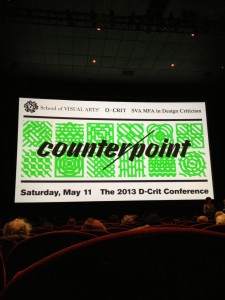Fiona Raby speaks at Counterpoint
The 2013 D-Crit Conference, School of Visual Arts, New York City
Attended 11 May 2013
Before hearing Fiona Raby’s talk at this Design Criticism conference in New York City, I had already visited Dunne & Raby’s new exhibition, “United Micro Kingdoms: A Design Fiction”, staged at London’s Design Museum, but the majority of the audience hadn’t. Fiona, however, gave such an insightful explanation of the show that, thanks to my notes from the day, this account of her talk might supplement my previous post about the exhibition, here. Following this is an Archive post from Eye Blog, reporting on the conference.
Fiona describes her practice (Dunne & Raby, est. 1994 in partnership with Anthony Dunne) as dealing with emerging technologies and imagined behaviours. She defines design as “a tool for collective imagining” and designers as “making it tangible”, the aim being to broaden our worldview.
Introducing the exhibition, she explains that Deyan Sudjic, the Director of London’s Design Museum, asked Dunne & Raby to propose a show, to create a “place to talk, a platform for discussion”. Keeping the focus “on small things”, Fiona recalls, “we wanted people to think about our own country (remember, she’s talking to a US audience) and our own lives”.
Constructing a “political compass” with two axes – authoritarian to libertarian, and political left to right – each of the four tribes fit a quadrant and each is in effect is a “live lab”. Left/Authoritarian = Communo-Nuclearists; Left/Libertarian = Bioliberals; Right/Authoritarian = Digitarians; Right/Libertarian = Anarcho-Evolutionists; expanded “biogs” of each tribe are on the website and appear as wall-graphics in the show.
Fiona admits that they were inspired to look at transport by Norman Bel Geddes’s work at the 1939 New York World’s Fair. [Visitors travelled through his General Motors “Futurama” diorama, presenting a vast stretch of America; gradually the scale shifted until they were deposited at a life-size, city intersection in front of a GM dealership; get the message!]
“We did a ton of research”, recalls Fiona, mentioning the team of experts they amassed for discussions, which included a political scientist, synthetic biologist, ethicist, economist and an author.
Mixing real and fictional media, they aimed to make the scenarios “both appealing and undesirable”, to factor-in complexity, to suggest that utopia might come at a price, and so might consumer choice. For the Digitarians, if everyone wants a Digicar, they have to deal with traffic jams, so tariffs control where and when they can travel. For the Communo-Nuclearists, they may be isolated, there may be no-growth, but the upside is a renewed diversity of wildlife, viewable through the windows of their nuclear-powered train that never stops.
Showing installation shots, Fiona explains why they kept labels to a minimum; “to leave it up to the viewer’s imagination”, adding that the exhibition’s microsite provides a forum for audience input and more information.
In a later Q&A Fiona elaborates on two issues relating to the exhibition; identity and participation. When asked how viewers reacted to the tribes, she suggests; “We hope they won’t identify with one group. We want people to see bits of themselves in each, so we made it open, complex and a little unsettling.”
Then a conversation about “critical design” questioned the challenges of developing participatory methods, and again, Fiona uses the exhibition process as an example. “I’m cynical about participation”, she suggests [audible intake a breath from the audience]. “Our meetings with experts weren’t about participation, they showed just how ‘silo-ed’ each profession is. But design could look at opening that up and suggest a number of different models of collaboration; not simply say, ‘everyone’s a designer’.”
As design practitioners Dunne & Raby used the idea of “design fictions”, within the context of a museum, to rehearse a vast array of scenarios. The results, from making and disseminating UmK go far beyond how to engage a design museum audience with objects that don’t yet exist, back into the design process itself. How might experts work together; how might individuals identify with imagined lifestyles; how might we assess the consequences of our consumer choices; and how do all those branches of science and technology (that impact choices from food production to energy generation) define us, our communities and our landscapes? It’s significant that these questions are being posed in a design museum, though, but the most significant development may be how this project lives on, after the show, via Dunne & Raby’s continued evolution of these ideas, and the website that archives them.

